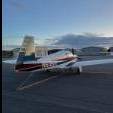Going back to the OP's posting, and with the caveat that without pictures it is much harder to assess paint and interior condition, I would guess that the plane as described should fetch around $75-80k in a private party sale, perhaps a bit more if Jimmy Garrison was selling it. I am calculating this against my own plane which I think would normally sell for around $75k (1970 E with 650 hours on a good overhaul with new cylinders).
-- The one the OP is selling has a lower timed engine from a reputable shop so that would count for more, maybe +$10k.
-- No autopilot and no engine monitor lower the value, at least for me they are a must -- -$10k (50% of cost to install new ones)
-- I don't know how to price the Rayjay turbo -- I'm sure it is great for high altitude takeoffs (not important for me as a low-lander), and probably gets you higher speeds at altitude, but at the expense of more maintenance -- $0
-- There is no mention on high cost items like tank reseals, landing gear shock disks; any damage history; hours flown in the last 2/5/10 years? I did not put a value on this, but this could add or subtract quite a bit.

